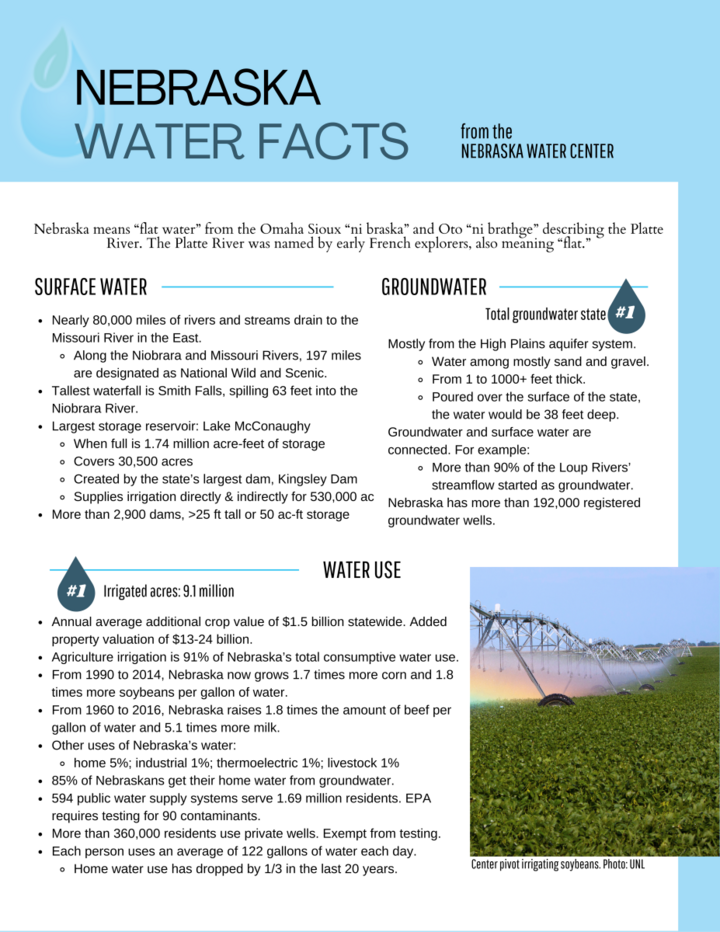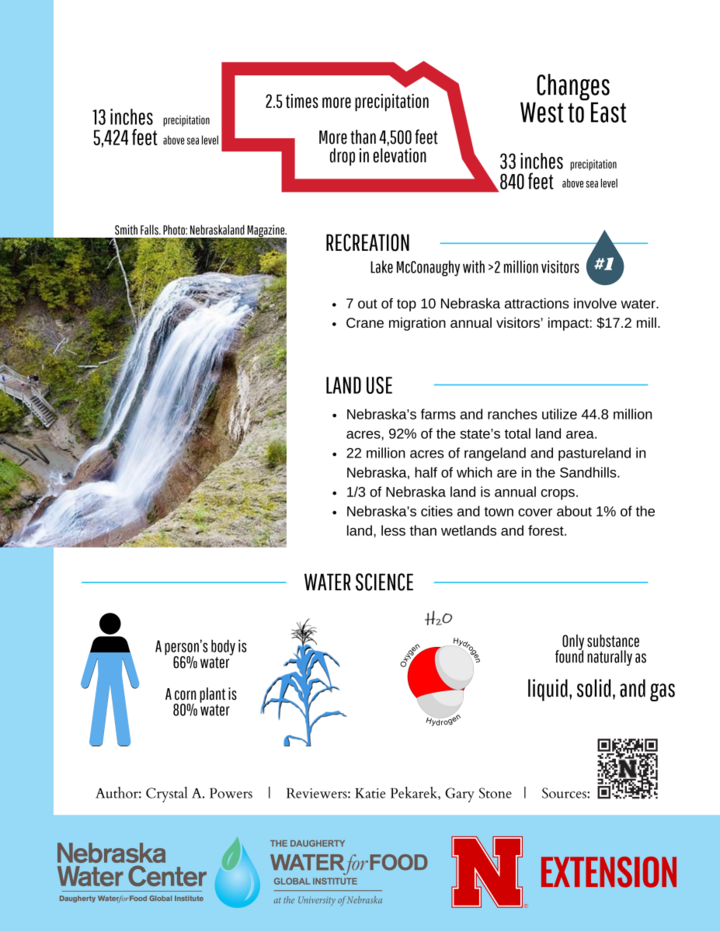Nebraska Water Facts


Nebraska Water Facts
From the Nebraska Water Center part of the Daugherty Water for Food Institute at the University of Nebraska
Nebraska means “flat water” from the Omaha Sioux “ni braska” and Oto “ni brathge”/ Nebraskier describing the Platte River. The Platte River was named by early French explorers, also meaning “flat.”
The Panhandle is almost 6.5 times higher elevation than the Southeast. (5,424 ft above sea level versus 840 ft)
Southeast NE receives 2.5 times as much annual precipitation as the Panhandle (average 33” versus 13”)
Surface Water (rivers & lakes)
Nearly 80,000 miles of rivers and streams drain to the Missouri River in the East.
- Along the Niobrara and Missouri Rivers, 197 miles are designated as National Wild and Scenic.
Tallest waterfall is Smith Falls, spilling 63 feet into the Niobrara River.
Largest storage reservoir: Lake McConaughy
- When full is 1.74 million acre-feet of storage
- Covers 30,500 acres
- Created by the state’s largest dam, Kingsley Dam
- Supplies irrigation directly & indirectly for 530,000 ac
More than 2,900 dams, larger than 25 ft tall or 50 ac-ft storage
Groundwater
#1 state in total groundwater, mostly from the High Plains Aquifer System, including the Ogallala Aquifer.
- Water among mostly sand and gravel.
- From 1 to 1000+ feet thick.
- Poured over the surface of the state, the water would be 38 feet deep.
Groundwater and surface water are connected. For example:
- More than 90% of the Loup Rivers’ streamflow started as groundwater.
Nebraska has more than 192,000 registered groundwater wells
Water Use
#1 irrigated state: 9.1 million acres
Annual average additional crop value of $1.5 billion statewide. Added property valuation of $13-24 billion.
Agriculture irrigation is 91% of Nebraska’s total consumptive water use.
From 1990 to 2014, Nebraska now grows 1.7 times more corn and 1.8 times more soybeans per gallon of water.
From 1960 to 2016, Nebraska raises 1.8 times the amount of beef per gallon of water and 5.1 times more milk.
Other uses of Nebraska’s water:
- home 5%; industrial 1%; thermoelectric 1%; livestock 1%
85% of Nebraskans get their home water from groundwater.
594 public water supply systems serve 1.69 million residents. EPA requires testing for 90 contaminants.
More than 360,000 residents use private wells. Exempt from testing.
Each person uses an average of 122 gallons of water each day.
- Home water use has dropped by 1/3 in the last 20 years.
Recreation
7 out of top 10 Nebraska attractions involve water
Lake McConaughy is the #1 Nebraska attraction with over 2 million visitors each year
Annual crane migration visitors’ impact is $17.2 million
Land use
Nebraska’s farms and ranches utilize 44.8 million acres, 92% of the state’s total land area.
22 million acres of rangeland and pastureland in Nebraska, half of which are in the Sandhills.
1/3 of Nebraska land is annual crops.
Nebraska’s cities and town cover about 1% of the land, less than wetlands and forest.
Water
A person’s body is about two-thirds (66%) water; A corn plant is about 80% water
Water is made of two hydrogen atoms and one oxygen: H2O
Only substance found naturally in liquid, solid, and gas forms.
This article was reviewed by Katie Pekarek, Gary Stone